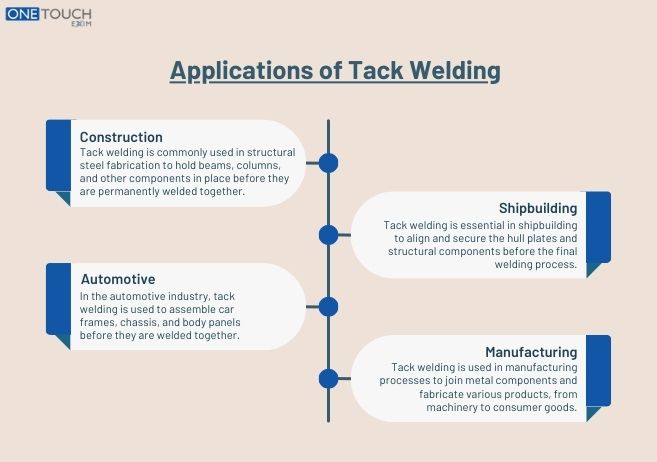Tack welding is a form of temporary welding to hold the metal components in an accurate position prior to completion welding. Tacks small rapid welds placed at regular intervals to keep the items hold in the correct position or to prevent warping during the main welding and widely used for the welding of various kind of cut including assembly and perfect for welding pipes and welding repairs, Tack welding is used in place where the construction and auto body work to ensure the proper fit up and joint accuracy.
Tack welds are generally produced by arc welding process with lower heat input for to minimize the warping. They need to remain aligned, but can easily be removed for final welding. Tack-welding in the right way gains high efficiency and increases weld quality. Tack welds have to comply with welding standards , including those intended to prevent defects such as cracks. They are integral to maintaining alignment and control of components on these welding parts.
How does it work?
Tack welding works as with joining small pieces of metal to hold parts in position before the final welding . These little welds – known as tacks – position and hold the piece in alignment while we attach for the main weld. Tacks are generally distributed along the joint and are about 1-2 inches long, depending on material thickness
and the size of the project. They are performed with the same welding process, just cooler , preventing distortion from excessive heat. Tack welds should be substantial to hold in place but should also be so designed that they can be ground, melted or otherwise disposed of when performing the full welding. If they are not set correctly, it can lead to an inaccurate fit or cost you something in the final weld. After being secured , the workpiece is fully welded, commonly using the tacks to complete.
Challenges in Tack Welding
Tack Welds are somewhere simple but also problematic because when tacks are wrongly located may result in miss alignment and gaps or distortion in the finished weld. Too much heat in a tack weld can burn through thin metals or cause them to become spoiled. Warping of componentry due to thermal expansion from tack welding can make final assembly difficult. Furthermore, tack welds should be matched to the base welding process as using incorrect filler material or procedure can lead to defects when the tack is integrated into the final weld. Tack welds cut to make adjustments may also undercut the base metal. The skilled welders need to balance the strength, spacing and heat input and maintain the cleanliness to avoid any type of loss.
Procedure and Distortion Control
When small temporary welds are placed to hold a part in the desired location to full welding. The joint is first cleaned and aligned, then the joint is observed or fitted to prevent movement. Following this are short tack welds between one and two inches spaced 3-6 inches apart with low efficiency and heat with minimal distortion. To limit distortion heat input is decreased by efficiency and travel speed. Tack welds can be used to reduce stresses and skip welding reduce the effect of excessive heat, Correct technique will provide correct alignment and prevent the distortion that would require unnecessary rework on final welds. Tack placement is monitored and adjusted to precise bonding for assembly.
Why it’s Important to Use
The main reason for using Tack weld in metal fabrication as it holds parts in the accurate location to avoid movement during final welding. Without the use of tacks, hangers may move from heat distortion or from handling, resulting in misalignment, spaces or structure. Tack Welds serve as temporary holding points, which enable fine tuning prior to making permanent welds, which in turn minimizes rework and material waste. They also serve to spread thermal stress uniformly, reducing warping and distortion in the final structure. In pipe lines and other configurations where the end differs from the body, tacks hold the parts in place during fit up to maintain the quality of the weld. They also save time and reduce scrap by holding parts in place during automated welding or high-volume runs. Tack weld quality also affects safety, since tack welds can keep heavy parts from shifting. In general, tack welds are necessary features for structure and economy in fabrication as well as a fundamental stage in the welding process.
Materials that can be tack welded
A variety of materials can be tack welded, including those that form carbon steel, stainless steel, aluminium and cast iron, alongside some unique alloys. Most of the mild steel is tack welded as this material is easy to weld and crack sensitive. The frequent control of the heat is to avoid warping. Aluminium is also very related to distortion and requires very high control and fast tracking to prevent burn through. Cast iron is difficult to do because it’s hard – usually it’s just before you weld and right after you need to cool it slowly. Copper and brass are also capable of being tack welded but not by conventional methods. Different materials require different filler metals, shielding gases and heat management to create strong, crack free tack welds that hold components steady until the final weld is completed.
Conclusion
Tack welds are the key to successful welding as they keep the work pieces correctly aligned, not allowing movement. This critical work eliminates distortion, reduces errors and improves the overall quality of welds on any kind of metal from carbon steel to aluminium. Tack welding enhances both production and repair operations by utilizing the appropriate techniques for each material applied as it should be, it eliminates weak spots and saves time in the shop. A fundamental skill welders must develop, tack welding gives you stronger, more accurate and less expensive results in manufacturing, building and repair work.
